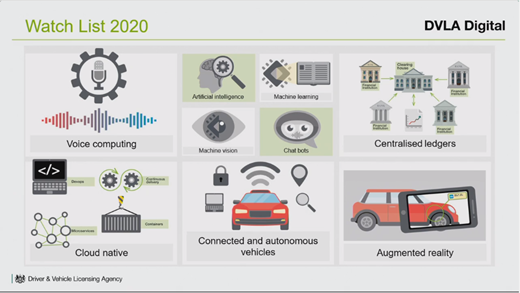- Why an Emerging Tech Lab?
- Chatbots
- Machine Learning
- Robotic Process Automation
- What hasn’t worked so well…
- Augmented Reality
Rob James is the Head of the Emerging Technology Lab at the DVLA. As his job title suggests, DVLA have taken a particular approach to testing and using new and emerging technologies to solve problems.
The DVLA have been developing proof of concepts to understand the tech and learn new skills, understanding how technology can create solutions to help design better citizen-centric services. We take a further look at these use cases as Rob explores technology such as AI, augmented reality, chatbots, RPA, and machine learning.
Why an Emerging Tech Lab?
DVLA have set up an emerging technology lab to listen, learn and share knowledge, to challenge the way things are done and to enable DVLA to delight users with truly 21st century connected digital experiences.
Their main aims are:
- To be curious, creative, open to experimentation and comfortable with ambiguity.
- To focus on the future of DVLA’s business, not optimising the current business.
- To move towards delivering DVLA’s strategic direction.
To better understand the future challenges and opportunities DVLA may face, within transport, some horizon scanning was needed to develop their Watch List for Government Emerging Tech in 2020.

Voice Computing is on the priority list for 2020, and DVLA were the first in country to develop a voice computing Alexa skill & Google Home skill. This means you can ask Alexa/Google if your car is taxed & requires an MOT!
Another crucial challenge for the DVLA will be connected & autonomous vehicles, which could see DVLA’s business shift. If autonomous vehicles mean less people driving, there will be less need for a driving licence therefore DVLA may have to accommodate more for vehicles and less so for drivers.
When touching on the topic of augmented reality, Rob smiled “I can’t talk about Augmented reality without a huge smile on my face. I absolutely love this technology & think it will really transform with the world around us in the future”. We go into some more detail on how the DVLA use augmented reality later on.
Chatbots
DVLA developed their first chat bot in 2017, helping to reduce their chat handling time of 2m 30secs with advisers now able to handle 19 chats per hour compared to 14 previously. There has also been a staggering 15% reduction in chat abandonment.
While keeping customer satisfaction at 90%, the DVLA have been able to decrease advisor handled demand by around 30,000 per month thanks to a 30% contact deflection from the bot’s ability to answer more simplistic enquiries.
Machine Learning
The DVLA were looking to digitise their driving licence applications. Applicants are asked to send a passport photo for their licence, which was sent to a human to approve. Using the DVLA’s Emerging Technology lab, the team trained a model to automate the process of approving photos that fit the correct standard. Applying machine learning, it was able to assess acceptable and unacceptable pictures with over 85% accuracy (using the minimum requirement of 100 images per tag).
Robotic Process Automation
RPA is being increasingly used across government agencies to become more efficient in processing low intelligence human processes while mitigating risks.
For the DVLA, RPA has been particularly useful for legacy IT systems when users were required to ‘re-key’ (reading information on one system and inputting it into another), saving time and resources.
What hasn’t worked so well…
Rob James shared with us an ambitious innovation project, which didn’t quite go to plan. The DVLA’s Driving Licence Reader project looked into how they could identify their customers in different ways.
DVLA’s users expect to be able to scan their licence in, to save them typing it out, but both on device and in cloud solutions were not accurate enough and took too long to process – deeming this project too high cost for the potential benefits.
Augmented Reality
Augmented reality is becoming an increasingly important part of our lives. For DVLA this helps customers visualise number plates on their cars, incentivising people to purchase from them rather than competitors.
Rob James delivered this case study at the GovTech Virtual Summit in October, part of the GovNet Technology portfolio.
The next event in the portfolio is GovTech 2021 on 12th October 2021, which focuses on advancing new and emerging technology in government. Register your place below!
Piers Kelly
Experienced Marketing Manager with a demonstrated history of working in the events services industry. Enjoys writing on Cyber Security, Emerging Tech & Digital Transformation. Marketing professional with a Bachelor of Arts (BA) in Politics and Economics from Newcastle University.



